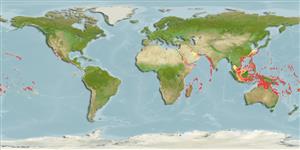Preferred temperature (Ref.
123201): 24.3 - 28.8, mean 27.5 °C (based on 750 cells).
Phylogenetic diversity index (Ref.
82804): PD
50 = 0.5000 [Uniqueness, from 0.5 = low to 2.0 = high].
Bayesian length-weight: a=0.00617 (0.00389 - 0.00977), b=3.22 (3.09 - 3.35), in cm total length, based on LWR estimates for this species & Genus-body shape (Ref.
93245).
Trophic level (Ref.
69278): 4.2 ±0.7 se; based on diet studies.
Widerstandsfähigkeit (Ref.
120179): hoch, Verdopplung der Population dauert weniger als 15 Monate. (Preliminary K or Fecundity.).
Fishing Vulnerability (Ref.
59153): Low vulnerability (14 of 100).
Nutrients (Ref.
124155): Calcium = 64.1 [23.5, 135.4] mg/100g; Iron = 0.578 [0.199, 1.239] mg/100g; Protein = 15.8 [12.9, 18.2] %; Omega3 = 0.0675 [, ] g/100g; Selenium = 34.7 [13.6, 80.4] μg/100g; VitaminA = 109 [28, 357] μg/100g; Zinc = 1.02 [0.59, 1.55] mg/100g (wet weight);
